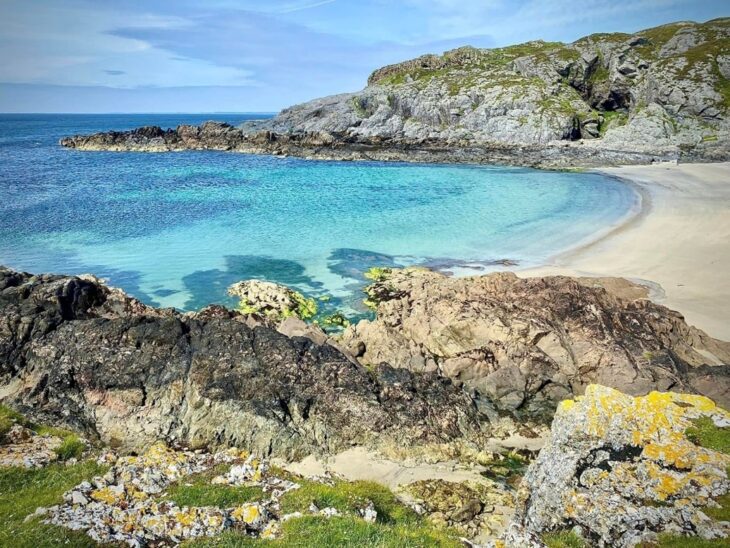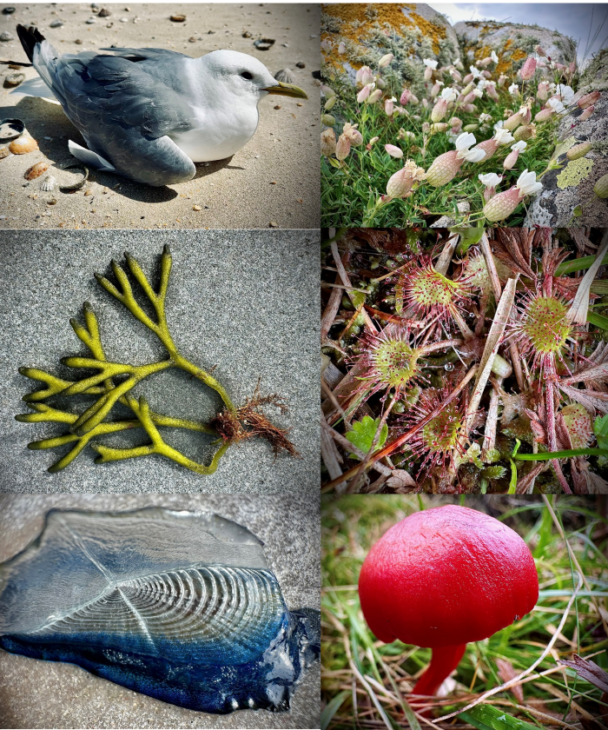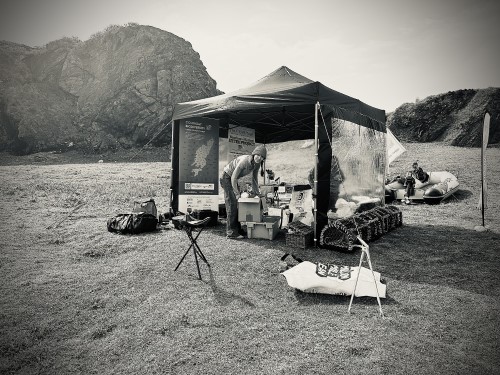About us
Colonsay Biodiversity – plugging gaps in knowledge about Colonsay’s marine environment
Colonsay Biodiversity – plugging gaps in knowledge about Colonsay’s marine environment

Colonsay Biodiversity is a volunteer-led initiative, working with the local community and the University of Glasgow to better understand the biodiversity of Colonsay, in particular its coasts and seas.
“It all began with an egg”.
So quoted zoology curator Mike G. Rutherford from from the Hunterian Zoology Museum at the University of Glasgow, at a talk at Colonsay Heritage Centre in May 2024. The egg in question belonged to a Flapper Skate (Dipturus intermedius) and it was found on Colonsay’s west coast high tide line on Valentine’s Day 2023. This find acted as the catalyst for recorder Jen Wilcox to establish Colonsay Biodiversity, a citizen science initiative and platform for collaboration.
The Flapper Skate is critically endangered and once the egg case was found and determined to no longer be viable, the sighting was reported and the egg case frozen and driven to the University of Glasgow for future research. Recognising that there was great potential for increasing the number of biological records from the area, the Colonsay Biodiversity project on iNaturalist was set up, and observations submitted there follow the data pathway to the NBN Atlas Scotland.
Recounting her motivation for this project, Jen Wilcox says:
“I’ve spent time on many Scottish islands and I was involved in various sea kayaking expeditions, artist residencies and research projects around Scotland’s Coast (& beyond) through past work and personal interest, spanning over two decades. My passion for Scotland’s seas has remained a life-long interest. Colonsay’s terrestrial landscape has been well documented over the decades by a few passionate enthusiasts, both island residents and visitors, but there is a large gap of knowledge and understanding in its surrounding seas, and Scotland’s seas in general. Up until this year only one Seasearch entry had been submitted. With a National and International push for Ocean Literacy, there is a lot of scope for this area to expand, and get creative!”

The Colonsay Biodiversity initiative led a number of events as part of Colonsay’s 2024 Spring Festival. This included running a BioBlitz and talks by visiting speakers from the University of Glasgow and Seasearch. These activities were supported by numerous island residents who volunteered their time and resources and the events were endorsed by the UN Decade of Ocean Science.
Mike Rutherford, who travelled from Glasgow, shares his experience participating in the project:
“As a museum curator I spend a lot of my time working inside with animal specimens, adding to databases and delving through archives, so being invited to help set up a biodiversity monitoring project was a great opportunity, and when that involved fieldwork taking place on a beautiful Scottish island surrounded by other biodiversity specialists and enthusiastic locals it made it even better. I was first contacted by Jen Wilcox as she wanted to donate a skate egg case she had found on Colonsay to the University of Glasgow, this soon grew into a plan to start a new project on iNaturalist to encourage locals and visitors to share their wildlife observations. And then it went further when I joined in the Colonsay Spring Festival in May 2024 by giving a talk and helping run a mini-BioBlitz. Hopefully, this will be the start of wonderful collaboration between many nature lovers to showcase the biodiversity of a little part of Scotland.”

Owen Paisley, from Seasearch also shares his thoughts on participating in the effort to record Colonsay’s marine life:
“As the seasearch coordinator for the west of Scotland I get to visit all sorts of places on the West coast and meet some amazing people and communities. Seasearch is a citizen science project that encourages sports divers to become involved in recording the stunning marine life present in Scotland’s seas. It’s been active for over 30 years with volunteer divers being responsible for almost 1 million species records around the UK.
However, there are some noticeable gaps in the survey records with Colonsay being one so when Jen invited me to bring a Seasearch team over to Colonsay to help with a biodiversity blitz I was more than happy to oblige. Putting together a multinational team of divers from Oban, Glasgow and Norway we arrived on the island on a Thursday evening to a great welcome from members of the community. The logistics of carrying out a diving survey are never simple with vast amounts of kit needed from heavy diving cylinders to cameras. The Colonsay community couldn’t have been more helpful, providing accommodation, food and helping transport heavy kit from cars to the sea.
Over the next 3 days we carried out 7 survey dives with over 150 different species recorded. One of the highlights for me was an evening talk in the community centre when I was able to share some of our findings from dense kelp forests to walls covered in colourful sponges. We can’t thank the people of Colonsay enough for their hospitality and when we left we were pleased to have at least made a start with recording Colonsay wonderful marine biodiversity.”’
Colonsay Biodiversity has demonstrated how working at a local scale, while collaborating with other organisations and experts, can help tackle a lack of knowledge and fill biodiversity data gaps for under-recorded areas and habitats. There is much scope for this initiative to expand and deliver benefits not only for biodiversity, but also for people, as Jen Wilcox explains:
“My personal struggles with a neglected illness are ongoing, and in between managing symptoms we’ve pulled together this project with grateful support from island residents. I hope it will be useful and appeal to many over time and merge with various projects already taking place on the island.
There is an inclusiveness about collaboration and sharing data and getting involved with: mapping/collaborating/connecting to and understanding the life and rhythms that surround us. We are heading into unprecedented times for climate change and biodiversity loss and by working together as a team to understand life on earth, we will be stronger moving forward. Data collection is a gentle pursuit, however it is amazing what can be accomplished when there is a little focus, energy & collaboration!
Parasites, fungus, algal blooms, plankton, butterflies, birds, pipe fish, common grasses, nudibranchs (sea slugs)… all life and patterns of change are of interest! This information should benefit all and although just a small part of any resilience plan, an important one.”
This biodiversity data story was shared by Colonsay Biodiversity with the Better Biodiversity Data project, led and managed by the NBN Trust and supported by NatureScot and The Scottish Government.
